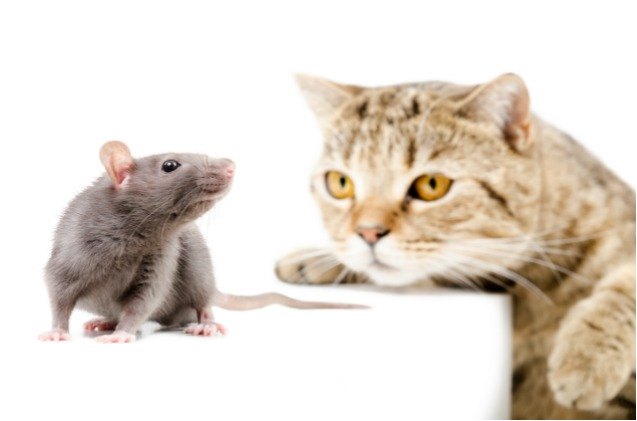Study: Cats Aren’t As Concerned With Rats As We Thought They Were

Researchers at Fordham University were conducting a study about rat pheromones and how they may affect rat behavior. Ecologist Michael Parsons said that they wanted to understand rats’ behavior based on their scents. Unfortunately for Parsons, the ‘rat-infested’ recycling facility in Brooklyn, New York also had some cats in the building, and Parsons knew he had to get rid of the cats in order to keep the rats ‘safe’ and observe them.
Related: UK Parliament Seeks Pussies to Help Get Rid of Rodents
Or did he? Parsons said that the cats were a bit more stubborn than he’d planned them to be–finding the facility quite comfy and cozy and they were not easily driven out. So, deciding not to waste time as cat eviction officers, they decided to see what studying cats and rats together could bring to science.
So Parson and his colleagues installed cameras all around the facility and tried to fit as many rats as they could with radio frequency tags (RFID) that allowed them to follow individual rats and observe their behavior. They then watched over 300 videos of cats and rats coexisting in the recycling center and found that the cats couldn’t seem to care less when the rats were on the open floor.
Parsons says that in one video, a rat seemed to happily and calmly walk the floor while a lazy cat simply watched it strut its stuff nearby.
That is not to say that there wasn’t some expected cat-chasing-rat violence that happened, but Parsons said it was rare. In fact, in the hundreds of videos they watched, they only saw three ‘ambushes’ that resulted in kills and 20 times they’d consider a cat stalked a rat. Basically, the cats couldn’t have seemed less put out by the rats.
The rats did seem to act more carefully around the cats, moving more often for a hiding place when they saw a cat, but really that just meant they walked more slowly when they moved colony to colony for new rubbish instead of running quickly. Running meant that you might pique a curious or playful cat’s interest, the researchers surmised for the rats.
Gregory Glass is a professor at the University of Florida who is not affiliated with the study but who has studied rat and feline interactions for years. He says that domestic cats don’t tend to be interested in rats because once they go through puberty, they are nasty and big and cats just don’t want to deal with them. In fact, he says that often he’s seen rats and cats being friendly as they’ve eaten happily out of the same trash bag.
Which means that programs like New York’s Mayor’s Alliance for NYC’s Animals, in which feral cats are ‘put to work’ for pest control may not necessarily be for rat control as much as for finding ‘homes’ for feral cats. In fact, Kathleen O’Malley is the director of education for the Mayor’s Alliance and says that their main focus is to trap, alter and release the feral cats, but when someone asks for feral cats for rodent control, they do their best to match them.
Related: London’s Postal Museum Seeking Picture Perfect Postal Pussy Cats
That means cats are not the greatest exterminators when it comes to rats, despite their reputation—and Glass says he scoffs at any initiative using cats to control rats. “What they do is a placebo. They make people who want to do something good feel better about themselves,” he says. “Sure, somebody might have a super-cat that will take lots of rats. But the super-cat will have to kill an awful lot of rats to make any sort of difference.”
So while we have images of rodents shaking in their boots as lurking kittehs roam nearby, science believes we may just be fondly reliving our Tom and Jerry days.

More by Lori Ennis























